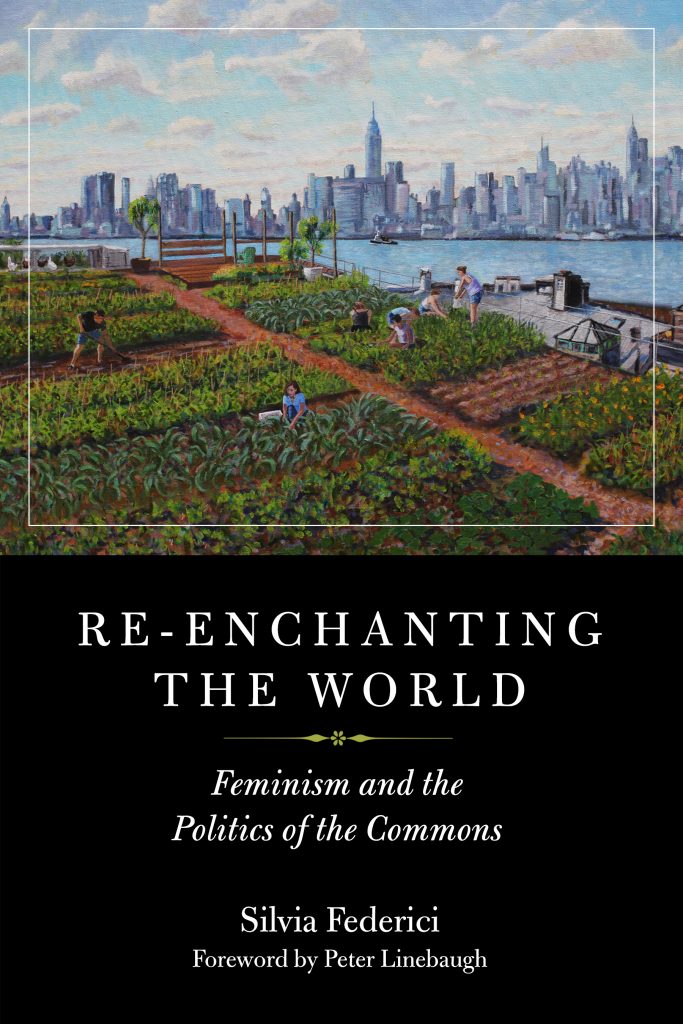By Katrina Hamilton
Socialism and Democracy
Sylvia Federici is perhaps the most prominent feminist Marxist scholar of our time. Her latest book, Re-enchanting the World: Feminism and the Politics of the Commons, encompasses two decades of her work. In 14 essays, Federici addresses the global political struggle for
egalitarian and equitable social arrangements via “commoning”. The commons may be understood as any particular space in which mutual beneficence is fostered. These spaces can be intellectual, meta- physical, or otherwise. However, more often than not, scholars enga- ging with the concept of the commons as it relates to the land and sustenance farming. In her introduction, however, Federici sets her work apart. Rather than referring to a particular thing, Federici argues that commoning “stands for the recognition that life in a Hobbesian world … is not worth living” (1). Rather, for Federici, the commons – or commoning – symbolize an ongoing political struggle against the ever-encroaching tendrils of global capital, one which is led by women.
Re-enchanting the World is arranged in two parts. The first, “On the New Enclosures,” provides readers with an overview and introduction to Federici’s concept of new enclosures. For Federici, the new enclosures signify the continued process of global capital accumulation. This claim is hedged against a simultaneous challenging and engagement with Marxist theory. As other scholars have argued, Federici and colleagues acknowledge that Marx’s concept of primitive accumulation in England cannot be viewed as an isolated event but instead as the first iteration of capitalist enclosure. This distinction is crucial and, as such, can be found throughout the entire collection. Equally important is Federici’s expla- nation of social reproduction. Not only is reproduction material, but it is also immaterial: cultural transmission, language, memory. It is at the crux of social reproduction and the new enclosures in which this work situates itself.
The first essay, “Introduction to the New Enclosures,” attributed to the Midnight Notes Collective, explains in depth the political and social circumstances distinguishing the current era of capital accumulation from its historical iterations. Within this essay, Midnight Notes argues that debt obscures the process of enclosure. In particular, the IMF is implicated as a central figure within these enclosures. In the following essay, “The Debt Crisis, Africa, and the New Enclosures,” Federici con- tinues this argument. Not only is the debt crisis contrived by global capital, but it is a productive and necessary measure by which the expansion of capital may take place. In particular, this essay highlights the role of structural adjustment programs (SAPs) in the reformation of African nations’ economies. It is through SAPs, Federici explains, that the recolonization of African has taken – and continues to take – place. Of course, where there is repression, there is resistance. Federici closes this essay with an overview of these struggles against debt enclo- sure and repression from Ghana to China. It is here, she argues, that the international proletariat may connect with one another, both concretely and abstractly.
The following essay, “China: Breaking the Iron Rice Bowl,” takes a slight turn to consider the role of state capitalism and China’s social unrest as it relates to the struggle in Tiananmen Square. Though it has been thirty years since Tiananmen Square, this essay remains poignant and relevant as China has become a central political consideration for Marxist scholars in the US once again. In this brief section, Federici out- lines the role of the western media in distorting Chinese political struggles against global capitalism through an analysis of New York Times articles.
Part I closes with “From Commoning to Debt: Financialization, Microcredit, and the Changing Architecture of Capital Accumulation.” This final introductory essay examines in more depth the thematic con- siderations outlined in earlier sections. In particular, Federici explores the rise of financialization under neoliberalism. Neoliberal debt econ- omics are positioned against pre-WWII debt formations, where commu- nities would lend to one another within their own reproductive means, as a privatized tool to express control over proletariat populations. These controls, of course, are met with opposition. Federici looks to Latin America for hope, connecting the struggle of US students against educational loans to their global counterparts in resisting debt.
Part II, “On the Commons,” draws the commons out of abstraction. In its nine essays, this section explores the ways in which feminist visions for more just social reproduction has happened or is happening across the globe. Its first essay, “Beneath the United States, the Commons,” contains a necessary acknowledgment of the destruction of native peoples’ rights and continued subjection to US control, arguing that struggles for the commons in the US must recognize indi- genous erasure. It is only through recognition and reparations for black and indigenous communities that a meaningful commoning project can take place. Following this brief chapter, Federici writes with long-time colleague George Caffentzis to distinguish the commons as an anti-capi- talist project. Chapter 7, “Commons against and beyond Capitalism”, includes a detailed examination of what exactly the commons are not. Caffentzis and Federici detail the appropriation of the commons by neo- liberal institutions which meanwhile promote the interest of capital. The following chapter, “The University: A Knowledge Common?” discusses the issue in more depth via a reflection of Federici’s own experience vis- iting the University of Minnesota. Here, she asks how universities reinforce the regimes of control which radical intellectuals may seek to challenge.
In the next three essays, Federici explores the role of feminism in com- moning. First, Federici argues that women are, and have always been, the central figure in the fight for the common as primary agents of social repro- duction. The theoretical points outlined in “Feminism and the Politics of the Commons in an Era of Primitive Accumulation,” can be understood more concretely through the exemplification of struggle and survival in both “Women’s Struggles for Land in Africa and the Reconstruction of the Commons,” as well as “Women’s Struggle for Land and the Common Good in Latin America.” In the latter, Federici describes an increasingly politicized base of women: Bolivian, indigenous, Guatema- lan, Zapatista, who “[make] visible how deeply rooted commoning relations are in our affective life … demonstrat[ing] that commoning is an irreducible aspect of our life, one that no violence can destroy, as it is continually recreated as a necessity of our existence” (146–147).
In her closing essay, “Re-enchanting the World: Technology, The Body, and the Construction of the Commons,” Sylvia Federici considers the role of technology in the escalation of capital’s accumulation. She writes “computerization has added to the general state of misery” (192) and argues that we must all consider the ecological and human impli- cations for ‘innovation.’ In contrast to a ‘pure’ Marxian vision of revolution, Federici calls upon the images of commoning and struggle to again center women as agents of change within the entangled web of global capital:
In different ways, through these new social movements, we glimpse the emer- gence of another rationality not only opposed to social and economic injustice but reconnecting us with nature and reinventing what it means to be a human being.
Re-enchanting the World is a timely and necessary text for scholars of all disciplines. Federici argues convincingly for feminist analyses of neo- liberal capital accumulation via the new enclosures. The collection’s format makes it particularly useful. For those versed in Marxist thought, one may choose to select essays directly related to interest. For those looking to develop their theoretical lens, a cover-to-cover reading may be more appropriate. Altogether, Re-enchanting the World impresses a simultaneous sense of urgency and hope. It is a fitting selec- tion for any reader.







